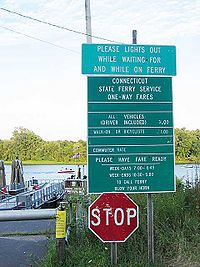Rocky Hill – Glastonbury Ferry
| Rocky Hill – Glastonbury Ferry | |
| 250px | |
|---|---|
| The Hollister III (barge) and the Cumberland (tow boat) | |
| Route | |
| Crosses | Connecticut River |
| Route | |
| Carries | pedestrians, bicycles, automobiles |
| Quays | Rocky Hill (41°39′59″N 72°37′47″W / 41.666363°N 72.629648°WCoordinates: 41°39′59″N 72°37′47″W / 41.666363°N 72.629648°W) to Glastonbury (41°39′56″N 72°37′36″W / 41.66565°N 72.626537°W) |
| Service | |
| Operator | Connecticut State Ferry Service |
| Authority | Connecticut Department of Transportation (ConnDOT) |
| Ferry(s) | Cumberland tows Hollister III |
| Type | towboat and barge |
| Frequency | as needed |
| Daily ridership | 400 |
| History | |
| Opened | 1655 |
The Rocky Hill – Glastonbury Ferry is a seasonal ferry crossing the Connecticut River between the towns of Glastonbury and Rocky Hill, Connecticut and is part of Route 160. It is believed to be the oldest continuously operated ferry in the United States.[1] The river crossing has an annual average daily traffic of 400.[2]
History
The ferry is the oldest continuously running ferry in the United States.[1] only shutting down in the winter when the river freezes over.[3] Started in 1655, it actually began before the foundation of the towns of Glastonbury and Rocky Hill, both towns being part of Wethersfield at that time.[4]
Originally a raft that was poled across the Connecticut River, it was then for a while powered by a horse on a treadmill before being upgraded to a steamship in 1876. Today's ferry is a 3-car barge named the Hollister III towed by a diesel towboat named the Cumberland.[1]
The ferry landings and the ferry itself are included in the Glastonbury-Rocky Hill Ferry Historic District, which was listed on the National Register of Historic Places in 2005. The National Register listing was proposed in 2005 to help preserve the historic ferry.[5] The historic district also encompasses farmscapes of the Great Meadows in South Glastonbury that preserve 17th-century land use patterns and Colonial and Greek Revival farmhouses, as well as the homes of shipbuilders and merchant traders near the two landings, including several examples of Colonial and Italianate architecture.[6]
Use
The ferry is the only river crossing accessible to pedestrians and bicyclists between Hartford and Middletown, preventing what would otherwise be a thirteen mile (19 km) detour for them.[7]
Operating between May 1 and October 31, the toll for cars is $3 and for cyclists & pedestrians is $1.[1]
In popular culture
- This ferry was used in the music video for Billy Joel's "River of Dreams".[8]
See also
- List of crossings of the Connecticut River
- Chester–Hadlyme Ferry, the second oldest continuously running ferry in the Connecticut operating just 25 miles (40 km) downstream.
- Glastonbury-Rocky Hill Ferry Historic District
References
- ↑ 1.0 1.1 1.2 1.3 "Rocky Hill - Glastonbury Ferry". Connecticut Department of Transportation. State of Connecticut. 2005-10-20. http://www.ct.gov/dot/cwp/view.asp?a=1380&Q=259738&dotPNavCtr=. Retrieved 2007-06-24.
- ↑ "2005 Traffic Volumes State Maintained Highway Network (Traffic Log)" (PDF). State of Connecticut Department of Transportation. pp. 134. http://www.ct.gov/dot/LIB/dot/Documents/dpolicy/traflog/traflog.pdf#page=134. Retrieved 2007-01-11.
- ↑ Oglesby, Scott (2006-10-22). "Routes 160-164". Connecticut Roads. Kurumi. http://www.kurumi.com/roads/ct/ctx160.html. Retrieved 2007-06-24.
- ↑ "The Rocky Hill - Glastonbury Ferry". Places of Interest in Rocky Hill, Connecticut. Rocky Hill Historical Society. http://www.rockyhillhistory.org/activities.htm#THE%20ROCKY%20HILL-GLASTONBURY%20FERRY%C2%A0. Retrieved 2007-06-24.
- ↑ Peter Marteka, Effort Could Earn Ferry, Neighborhoods Historic Designation; What May Be The Oldest Continuous Service In U.S. Was Once At Risk From Budget Cuts, Hartford Courant, April 1, 2005
- ↑ New Listings on the National Register, Connecticut Trust For Historic Preservation
- ↑ Sokolowski, Kenneth E. (2005). "Rocky Hill Glastonbury Ferry Now 350 Years". Wethersfield.NET. Kenneth E. Sokolowski. http://www.wethersfield.net/html/gov/ct/rhill/ferry/ferry-info.html. Retrieved 2007-06-24.
- ↑ Offset 1:40[citation needed]
External links
| ||||||||
- All articles with unsourced statements
- Articles with unsourced statements from June 2009
- Articles with invalid date parameter in template
- Pages with broken file links
- Glastonbury, Connecticut
- Ferries of Connecticut
- Transportation in Hartford County, Connecticut
- 1655 establishments
- Historic districts in Hartford County, Connecticut

